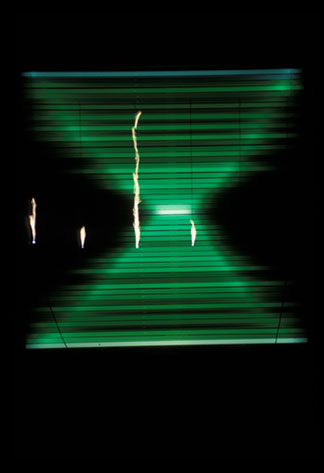
Silence, First: Light-Art by Cork Marcheschi
September 26 - December 13, 2015 AdmissionCork Marcheschi is internationally known for his architecturally-scaled public light sculptures that feature soaring modernist forms and jewel-box colors. His earliest experiments with light-art, however, beginning in 1966, were more direct explorations of the intersection of art and electricity. Marcheschi combined his passion for avant-garde electronic music with an interest in the work of the nineteenth-century inventor Nikola Tesla, he of alternating-current fame. Marcheschi’s early pieces reveal the workings of electricity in its most raw form as he leaves exposed an elementary arrangements of wires, transformers, and fittings that create pulsating light environments.
The mid-1960s was a time of wide-spread interest in light-art, when artists like Dan Flavin and James Turrell turned light into a subject—the thing to be seen—rather than just a functional element that illuminated something else. This was a minimalist art form that was concerned primarily with sensory perceptions, with how the use of light and color could create an environment and affect the viewer’s experience of it as both a physical and psychic space.
Marcheschi’s was not the clean ascetic minimalism of Flavin, where the appreciable physics of electricity is subordinate to an aesthetic concern for transforming space. Like Flavin, Marcheschi employed commercially available fluorescent light fixtures, a nod to the ready-mades of Dadist Marcel Duchamp. But Marcheschi directly involved the viewer’s participation in activating his light sculptures by having the viewer step on a foot pedal to start the show. This action releases energy from a 15,000 volt transformer, which sends arcs of electric current jumping across suspended wires. This effect, known as “Jacob’s ladder,” consists of a pairing of two conducting electrodes separated by a gap that encourages an arc of electricity to climb between them. The action is violent and disruptive and leads to the dramatic snapping and sparking (and smell). A secondary procedure electrifies two crossed wires strung behind stacked fluorescent lamps. The stimulation of these wires excites the gases contained in the glass tubes and causes them to illuminate in random, jerky sequences and patterns.
All these spectacular elements contribute to a sense of performance during their engagement, for this light-art is an art that acts: there is its quiescent potential followed by noisy realization, dark then light, off and on, activation and cessation. These dichotomies constitute a staged experience—silence, first; fluorescence; silence again.
